Simple Recipe for Homemade Weed Killer That Works

Looking for easy ways to get rid of weeds? There are lots of simple ways to suppress or kill weeds without the work or use of herbicides. Here are 5 easy ways to manage weeds and plus a simple recipe for a homemade weed killer that works!
Yes, weeds are totally annoying. But there’s no reason why they have to be so hard to kill.
Weeds are everywhere. They grow in yards, gardens, parks, roadsides, and even sidewalks. They’re also very difficult to remove completely.
So it’s important to keep up with it.
With the new house, comes more gardens and LOTS of places for weeds to sprout.
Because I prefer to use organic methods of weed control, I pull or hoe most of them out of the gardens.
We have two ponds, two dogs, a family, have a well, and live near a babbling brook, so acting responsibly with pesticides is paramount.
To me, the most effective method to get rid of weeds is to pull them out by the root.
But I have to admit there are times when I just don’t feel like doing that. Particularly when I have a large patio, pathway or paver area to weed out.
If you love a well-manicured garden and perfect lawn but prefer not to use harsh chemicals, there are simple homemade weed killers you can make and methods to use.
Wait until you see how to kill weeds using these everyday household products plus a simple recipe for weed killer that works!
How to Manage Weeds in the Garden
What’s the best method for managing weeds in the garden?
For starters, use a combination of pulling weeds and planting smart.
What does planting smart mean?
Grow plants slightly closer together to help crowd out weeds or use ground covers to help keep them from popping up.
Add lots of mulch and make it a priority to keep plants healthy.
Hometalk Recommends!
In addition to planting smart, pull weeds as you see them and be sure to get at them from the root.
If you walk your gardens every day, pull what you see when you see them.
Don’t wait to remove them because weeds can get out of control pretty quickly.
I love to use THIS hand tool and THIS stand-up weeding tool to help get plants out with the root.
As part of a multifaceted approach to removing, killing and suppressing weeds, it’s also effective to use homemade weed killers.
A word of caution though about them though.
Use these methods sparingly because they are non-selective and will also kill the good microbes too.
5 Easy Ways to Kill Weeds in Your Garden
If you want to try killing or suppressing weeds without having to pull or hoe them out, give one of these methods a try.
Each method is non-selective meaning it will kill anything around it so be mindful with the application of each.
They are easy to do and you likely have the products on hand in your home.
- Boiling Water
- Propane Torch
- Rubbing Alcohol Solution
- Corn Gluten
- Recipe for Homemade Weed Killer Using Vinegar
Boiling Water Method to Kill Weeds
If you have a few weeds to remove, boiling water is an easy way to kill them.
I tend to use this method on small pathways and patio areas because there isn’t vegetation I want to protect around it.
It’s not as easy to use when you have more weeds to get at or larger areas to weed because you have to keep going in and out to boil water.
But it is a very effective method that works quickly.
Simply boil water and pour it on the weeds on a warm, dry sunny day.
That’s it!
Propane Torch Method to Killing Weeds
I’ve tried this method before and it takes a little more doing so it’s my least favorite. And to be honest, I prefer not to do it.
If you want to try it though, you’ll need a propane torch like THIS that is specifically made for killing weeds.
The idea behind it, is you burn the weed down to the root.
Last year, I tried this in my driveway where lots of weeds were sprouting, and found the process to be a bit laborious.
It took a while to burn each weed, I had a lot of weeds to deal with, and you go through the propane pretty quickly.
Plus, it took some doing to get the torch going.
Now it could have been the amount and/or type of weeds I had, but to me, it was more work standing there holding the torch and waiting for each weed to burn and die before moving on to the next one.
This method just wasn’t for me.
The Rubbing Alcohol Method
If you’d rather go with a solution, a rubbing alcohol mix is pretty straightforward to make.
To prepare it, simply mix one quart of water to dilute two tablespoons of rubbing alcohol.
Note: Before applying this method to weeds, wear gloves and protective eyewear.
Simply apply the rubbing alcohol mixture on a dry sunny day without wind. Saturate the foliage, stem, and plant base to get at the roots.
For me, I don’t typically use this method but it does work.
How to Use Corn Gluten to Suppress Weeds
Unlike the aforementioned approaches to weed control, corn gluten does not kill weeds but rather helps suppress them when applied at the right time.
It is most commonly used to keep crabgrass at bay in the lawn, but can also be applied in garden beds between plants to help keep weed seeds from germinating.
For this method to be effective though, it must be applied with crabgrass seed germination.
How do you know when that is?
In spring when the forsythia starts blooming in your area until the last bloom drops, is the right time to apply it.
Simply spread it over the soil and water it in well after.
Although its important to water it in after applying it, you’ll want to apply corn gluten on a dry day with a few dry days in the forecast so it has a chance to work without getting washed out by inclement weather.
Simple Recipe for Homemade Weed Killer That Works
Now that we’ve covered some alternative methods to pulling or hoeing weeds, this homemade weed killer recipe is my go-to method when I don’t want to pull them.
This simple recipe for homemade weed killer is vinegar-based and covers large areas in a reasonable amount of time.
And with the size of my patios, pathways and garden areas, I need to cover more ground.
What I love most about this recipe is there is NO NEED to use synthetic pesticides to get the same effect.
So if you are looking for ways to kill weeds organically without having to pull them, try this simple recipe for homemade weed killer instead.
But like I said before, keep in mind it is non-selective and kills both bad and good microbes.
For me, I only use this in hardscaped areas and protect my plants if they are nearby.
Ingredients for This Recipe for Homemade Weed Killer
Not much is needed to make your own homemade weed killer recipe and you likely already have the ingredients laying around your house.
While you can use any distilled or apple cider vinegar, vinegar containing more than 11% acetic acid will work best to burn and kill weeds.
Here’s what you need:
- Distilled, apple cider, or cleaning vinegar
- Salt
- Dish soap
- Spray bottle
While any dish soap will do, I think Dawn dish soap works best.
But why do you need dish soap if vinegar is the acting ingredient?
Because the dish soap helps the vinegar stay on the surface longer.
So be sure to apply this recipe on a sunny day so it does not get washed away.
How to Make Homemade Weed Killer with Vinegar
Start with a gallon of vinegar.
Add one cup of salt and 1 tablespoon of dish soap.
Simply pour the ingredients into a spray bottle and shake well.
Note: Before applying, wear gloves and protective eyewear.
It is best to apply the vinegar method on a dry sunny day with little to no wind, so the rain does not wash it away.
The sun helps dry out and kill the weeds so timing is everything.
And it is best to apply on a non-windy day so the overspray does not hit other plants and vegetation you want to keep!
How to Apply the Vinegar Method
To apply, spray directly on weeds and the foliage. Try to get all of the plant, including the base so the solution gets to the root as well.
This solution is non-selective so be careful not to spray other plants.
Use a piece of cardboard or something to keep the overspray from hitting other plants if need be.
Conclusion
In short, homemade weed killers kill whatever plants they touch, which includes the lawn so be particularly careful if you choose to use them.
It’s also important to note that when used repeatedly, they change the soil composition, so use them sparingly in the garden or the lawn.
Always wear gloves and protective eye wear when working with herbicides.
And if you have any questions about how to use homemade weed killers, consult your local cooperative extension or master gardener helpline because they are very knowledgeable and can share what works best in your area.
While there are many ways to manage weeds in garden beds, the best approach is to pull them out from the root.
It’s organic, it’s therapeutic, is very effective, and you don’t risk damaging surrounding plants with something that is non-selective.
Yes it is a little more work, but it’s better for the garden.
I walk the gardens every day and pull them as I see them so it’s less work long term.
For more gardening tips, tricks, and inspiration, CLICK HERE.
Simple Recipe for Homemade Weed Killer That Works
Looking for easy ways to get rid of weeds? There are lots of ways to suppress or kill weeds without the work or use of herbicides. This post shares some easy solutions plus a simple recipe for homemade weed killer that works!
Prep Time5 minsTotal Time5 mins
Calories:
Equipment
- 1 gallon spray bottle
- 1 work gloves
- 1 protective eye wear
Materials
- 1 Gallon Vinegar
- 1 Cup Salt
- 1 Tbsp Dish Soap
Instructions
- Mix vinegar, salt and dish soap in gallon container.
- On a bright sunny day with no wind, saturate weed plant, foliage, stem, and base well.
NotesIf using near garden plants, grab a piece of cardboard to protect them from potential overspray.
Pin and Save It For Later
Please Save and Share This Post!
If you like this post, please share and pin it on Pinterest. (If you hover over the image, the Pinterest button will be in the upper left corner.) I’ve created the below-custom pins for this post.
Subscribe to the blog and gain access not readily available to the public.
Thank you so much for following along.
Enjoy a beautiful day! xo
Let’s Connect!
If you like this post, please follow me @bricksnblooms on Pinterest, Facebook, Instagram, and Tik Tok. Subscribe to my YouTube Channel. Or join my Facebook Group.
Enjoyed the project?
Resources for this project:
See all materials



















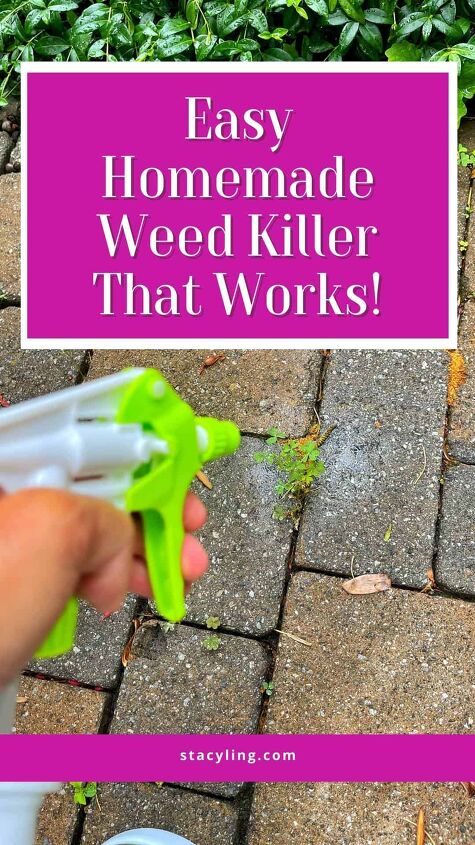






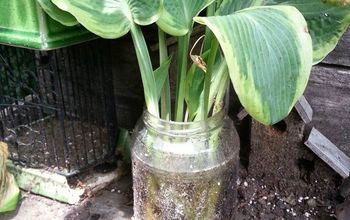















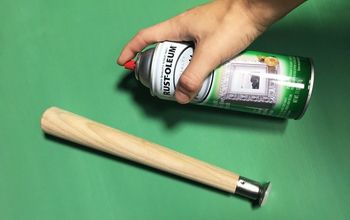


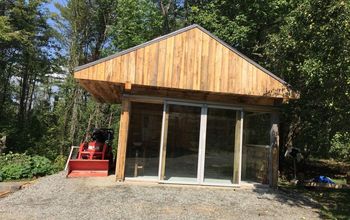
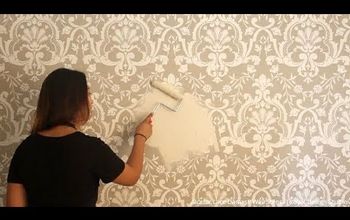


Frequently asked questions
Have a question about this project?
What is corn gluten?
I'm right there with you one pulling the weeds by the roots!!! I also garden organically. Living in Ks. The weeds shoot up after a rain then dry into the soil like cement. I have 3/4 acre so pulling them all after a rain before the dirt drys out. My Solution??!!! Water the ground where you want to pull weeds!!! Makes it So So much Easier to Pull Em By the Roots!!! My hubby prefers weed eating them short. 😅🤪🙄 City boy.
I would like to use mixture. I would like to know if flowers can be planted in an area that has been sprayed and how long should you wait after spraying?